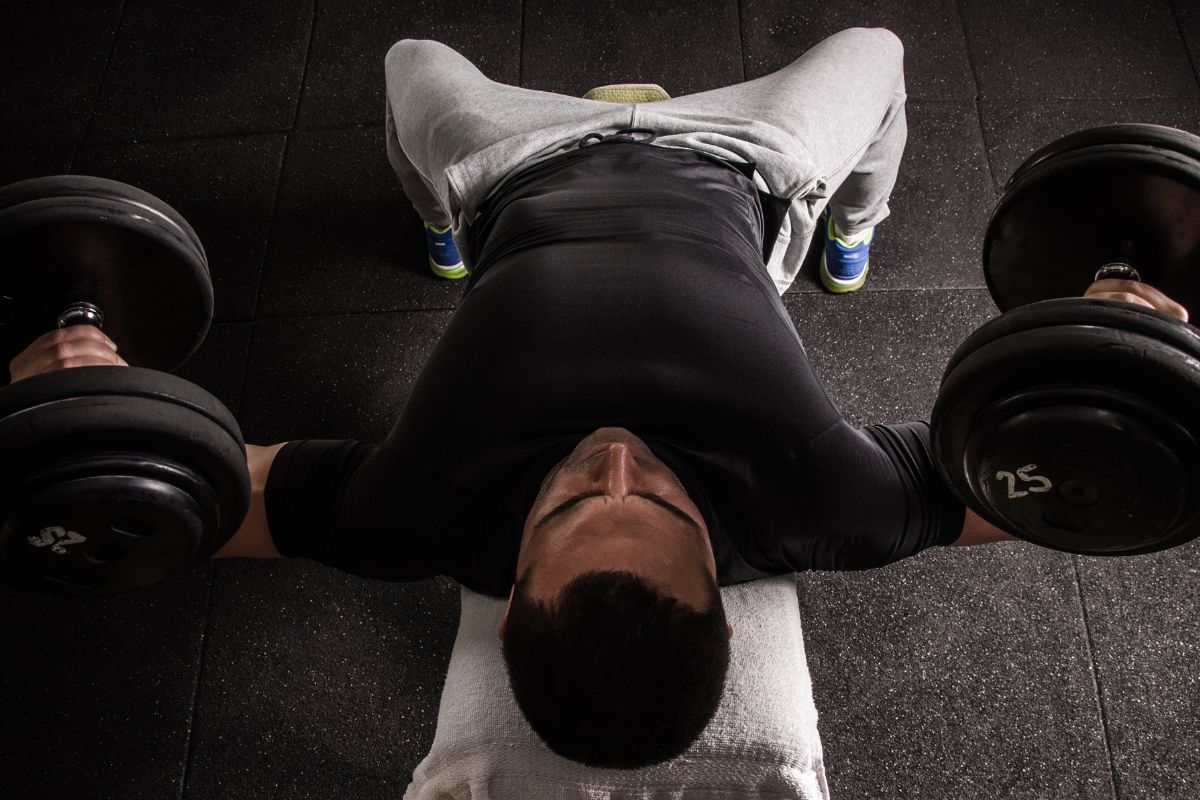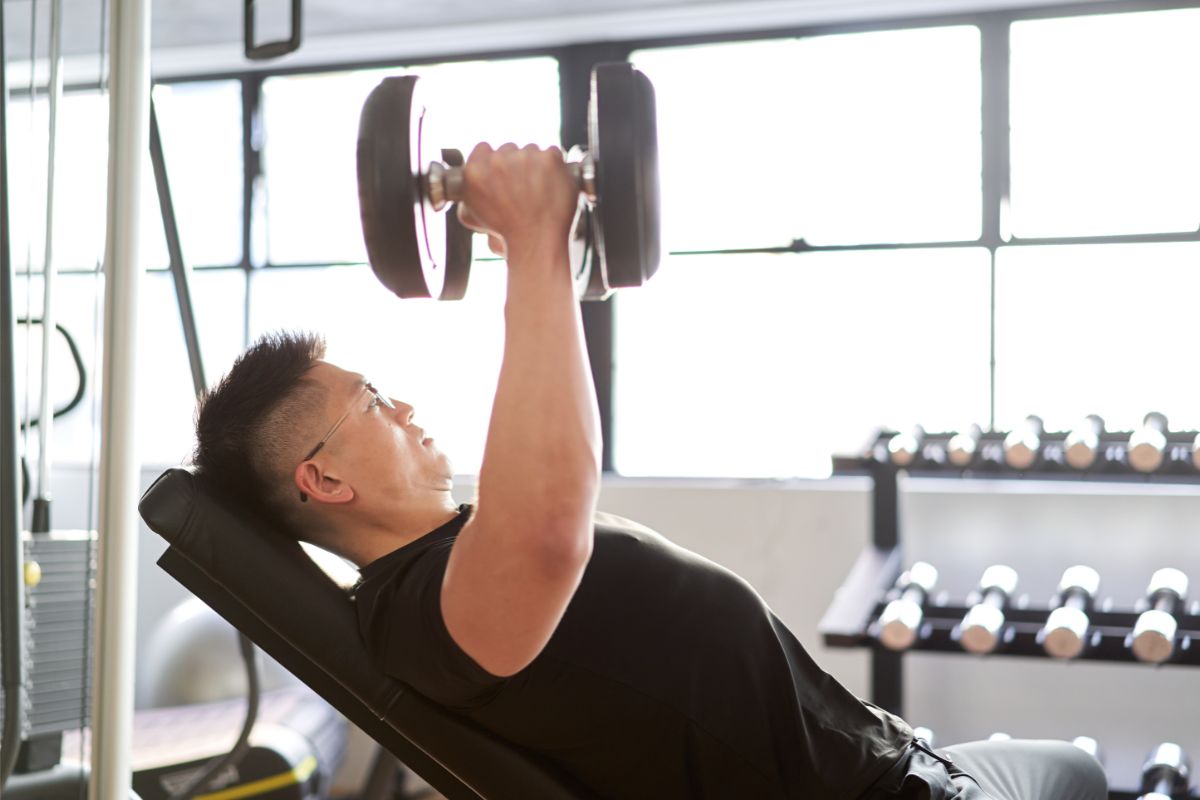Last Updated on December 4, 2022 by admin
The pectoralis major is the largest muscle of the chest wall. It is responsible for raising the arm out to the side and lowering it down toward the body. That is why it is important to add the Incline Dumbbell Fly to your routine.
The pectoral minor assists the major by moving the shoulder blade forward and backward. The teres major stabilizes the scapula in movement. This muscle helps stabilize the arm while lifting weights.
The incline dumbbell fly works the pectoralis major muscle group, which includes the upper chest, clavicle, and shoulder blade area.
This muscle group is often neglected during chest training because most people don’t realize how important it is to overall fitness.
But the pectorals are responsible for many movements, including lifting heavy objects, pushing against resistance, and stabilizing the scapula while you sleep.
They also play a role in breathing, helping us take deep breaths and inhale oxygen into our lungs.
Let’s look at how we can strengthen this important muscle group.
How To Do The Incline Dumbell
To do the incline dumbbell fly correctly, you must use proper form. If done incorrectly, the movement could cause injury so make sure you follow the steps outlined here to perform the incline dumbbell flight safely.
- Step 1: Lie faceup on an adjustable bench set up on an incline bench. Stand behind the bench and grasp one end of the barbell with both hands, keeping the bar close to your body. Your arms should be straight out in front of you, elbows locked.
- Step 2: Lift the bar off the floor and hold it above your shoulders.Make sure your elbows are bent 90 degrees.
- Step 3: Lower the weight slowly toward your chest. When the bar reaches about halfway down your chest, pause and squeeze your pectorals together.Then push the bar away from your body, extending your arms straight over your head and squeezing your shoulder blades together.
- Step 4: Slowly lower the bar back to the starting position. Repeat 15 times.
Secondary Muscle Groups
The primary function of the biceps brachii muscle group is to pull objects toward the body. This includes pulling things up into the air, such as lifting weights or hanging onto ropes.
However, the biceps also play a secondary role in stabilizing the elbow joint. This helps prevent injury while working out.
When performing exercises like dumbbell incline fly you use the biceps to assist in holding the weight down against gravity.
Benefits
Shoulders
The incline dumbbell fly exercise targets the pectoralis muscles, the anterior deltoids, and the triceps brachii. This is one of the best shoulder strengthening exercises because it works multiple areas of the shoulder complex.
When performing this move, make sure to keep your elbows close to your sides and avoid letting them come out too far. You want to hit the target area without hitting the elbow joint.
Chest
There is no doubt about it: the upper chest is one of the most important muscle groups in the entire human body.
As we’ve mentioned the upper chest consists of three main parts: the pectoralis major, the anterior deltoid, and the serratus anterior.
These three muscles work together to support our shoulders and neck. They also play a role in breathing, movement, and overall stability.
In short, without strong upper chests, we cannot be healthy.
So what does this mean for weightlifters? If you consistently neglect incline chest exercises such as the pec fly, you are overtraining your lower, sternal head and under training your upper, clavicular heads.
And this needs to be addressed and included in your exercise routine.
Wide Range Of Motion
Another benefit of the incline dumbbell fly is that it offers a wider range of motion than many other chest exercises because it places less strain on the shoulder joint. This makes it ideal for people who want to avoid pain or injury while working out.
The incline dumbbell press works every major muscle group in the upper body and is one of the best exercises for building strength and endurance.
What To Avoid

Although this exercise is easy it requires some technique adjustments and there are certain things you need to avoid to prevent injury.
Bending Elbows
A common mistake among people who do incline dumbbell flyes is allowing their elbows to bend excessively during the movement.
When you perform the exercise, keep your forearms parallel to the floor throughout the entire range of motion. If you find yourself bending your elbows too much, try lowering the weights slightly.
Another mistake is failing to fully extend your wrists while lifting the weights. Make sure your hands are completely straightened out before beginning the set.
Using Arms Instead Of Chest
The incline dumbbell fly is one of the best exercises for building strength in the upper body. However, it can be difficult to perform correctly without proper form.
One common mistake made during the movement is allowing the arm muscles to carry too much of the load.
If this happens, the lifter becomes focused on bringing their hands together rather than keeping their elbows locked throughout the entire set.
This causes the weightlifter to focus on moving the bar up the torso rather than pushing off the floor with their legs. As a result, the lifter uses their arms rather than their chest to complete the lift.
To fix this problem, make sure you keep your elbows locked throughout the entirety of the set. You should feel as though you’re bringing your elbows together at the top of every repetition.
Overstretching
Many lifters let the dumbbells fall too low towards the floor at the end of each repetition. This causes excessive stretch in the muscles surrounding your elbows.
When you pull the dumbbells up again, the force on your arms is much greater than normal because the muscles have been stretched out. This puts undue strain on your shoulders and upper arm tendons.
If you want to avoid injuring yourself, keep your hands slightly above chest level throughout the movement.
Also, don’t allow the dumbbells to drop to the floor during the eccentric portion of the lift. Instead, use the momentum of the bar to help you complete the rep.
Variations
There are several variations of the incline dumbbell flyes that target different areas of your chest. Here are some of my favorites:
- Incline Dumbbell Fly With Push Ups – Do push ups while holding a dumbbell in each hand. Perform three sets of 12 reps per arm.
- Incline Dumbbells Fly With Rows – Hold a pair of dumbbells above your head, keeping your elbows close to your sides. Perform three sets of 15 reps per arm.
- Incline Dumbbell Fly Overhead Presses – Stand over a weight bench and hold a pair of dumbbell overhead. Perform three sets of 8 reps per arm.
- Incline Dumbbell Fly With Pullovers – Lie face down on a flat bench and grab a single dumbbell in each hand, palms facing away from you. Lift your arms straight out to your sides and perform pullovers. Complete three sets of 20 reps per arm.
Around the World Dumbbell Fly This exercise targets your pectorals and triceps. Start by holding dumbbells in front of you. Your palms should face each other.
Slowly lower the weights down toward your shoulders while keeping your elbows close to your body. As soon as your arms reach parallel to the ground, raise them up again. Continue moving in circles around your torso.
Upward Fly
This exercise is just like the standard incline dumbbell fly except you don’t use a bench. Instead, you’ll hold a pair of dumbbells above your head.
Start standing tall with your feet shoulder width apart and your hands holding the ends of the weights directly over your shoulders.
Keeping your chest up and your core engaged, slowly lower the weights down toward the floor while maintaining balance.
Pause briefly at the bottom and then push yourself back to the starting position without resting on your heels. Complete 10 reps and repeat three times.
Conclusion
The incline dumbbell fly exercise is one of the best exercises for building strength and size in your pecs. It’s also an excellent way to strengthen your chest muscles and improve your posture.
However, if you do it incorrectly, you can easily injure yourself. If you follow these guidelines, you won’t have any problems performing the exercise correctly.
Another benefit of the dumbbell fly is that it works all major muscle groups including your biceps, forearms, deltoids, and triceps. You can even add it into your workout routine after doing curls or rows.

